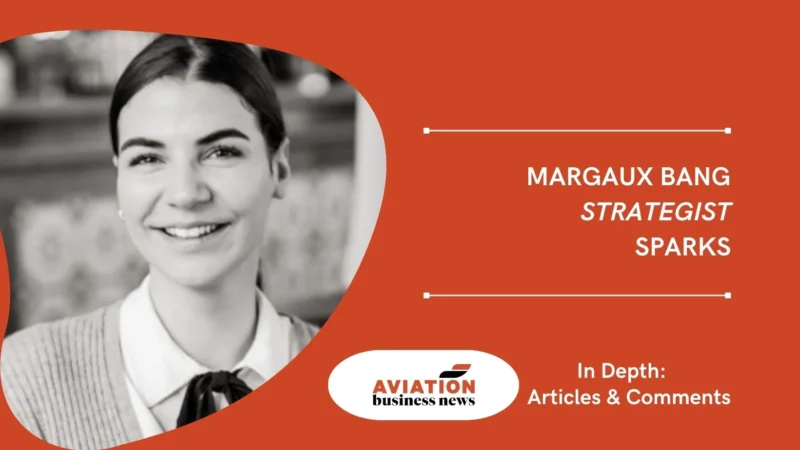Margaux Bang, strategist at brand experience agency Sparks, says the value of operating in a more environmentally friendly way cuts through more than cost and sacrifice
Today, in the high-tech corridors of aviation and the carbon-accounting realities of ESG, we’ve lost sight of the truth that it takes more than evidence to propel change.
For the science of sustainability needs to be felt – through experience, through emotion, through human connection.
As we build the future of sustainable aviation, we need the fusion of imagination and evidence.
Because no matter how cutting-edge our solutions, ESG fatigue is real and it isn’t a failure of action, it’s a failure of imagination.
Experience is the antidote to apathy
The aviation sector faces a paradox: it is one of the most vital industries to decarbonise but the moves it is making in that direction are not being felt.
Sustainable Aviation Fuel (SAF), electric propulsion, new infrastructure and the technical efforts are monumental.
But the public doesn’t feel them. This is where experiential marketing becomes not a luxury, but a strategic necessity.
Experiences build trust in ways data can’t. When people witness innovation with their own eyes, when they stand inside a net-zero aircraft cabin or engage with immersive sustainability journeys, they start to believe.
Brands doing this effectively are those that let people feel sustainability rather than read about it.
Immersive activations, demo flights or VR experiences can all turn abstract numbers into lived memories. This shifts ESG from compliance to something desirable and human.
TotalEnergies at the 2025 Paris Air Show used experiential marketing to demystify SAF and highlight the infrastructure challenges slowing its adoption.
At its booth, the company recreated a fully immersive SAF-powered airport environment – a physical manifestation of a concept typically confined to technical whitepapers and policy discussions.
By simulating what a SAF-enabled airport could look and feel like, TotalEnergies made an abstract future tangible.
This hands-on experience helped stakeholders – from policymakers to aviation executives – better grasp the logistical hurdles and opportunities tied to adopting SAF.
The installation reinforced TotalEnergies’ commitment to decarbonising aviation, translating complex ESG issues into actionable, engaging narratives.
Building emotional connection with passengers
The public may not grasp the carbon lifecycle of SAF, but they remember boarding a plane fuelled by it.
They may not read emissions dashboards, but they remember being immersed in a space where sustainable flight feels real.
The United Airlines’ historic passenger flight using 100% SAF in 2021 was a technical milestone and a strategic move to engage the public emotionally and promote sustainability.
The flight was positioned as a tangible example of progress in decarbonizing aviation, aiming to transform abstract environmental goals into a relatable and hopeful narrative.
By involving passengers and industry leaders, United sought to create a sense of shared accomplishment and personal connection to the sustainability effort.
Why airlines need to rethink their ESG marketing strategies
Airlines rely on data-heavy reports or fragmented campaigns that don’t resonate with passengers.
They’re good at setting targets and piloting new technology, but weak at translating that into customer experiences so, their ESG marketing needs to be reframed.
To increase consumer willingness to pay for sustainable travel, airlines need to make sustainability exciting and aspirational; a rewarding experience rather than a moral imperative.
Brands can better share the successes of how they have implemented ESG, such as including SAF seat upgrades or green booking options.
They can reward sustainable choices through loyalty programmes and premium perks, sharing proof through storytelling rather than just statistics.
ESG storytelling must move from solo to systemic
Aviation’s decarbonisation isn’t a solo act. It’s a system-wide, multi-stakeholder evolution. Yet the public often sees only fragments – a single innovation, a new fuel type, an airline campaign.
Events like the Paris Air Show, Dubai and Farnborough offer rare opportunities where the entire industry convenes in physical space.
Air shows are primarily industry-focused but their impact extends far beyond B2B audiences. The innovations and demonstrations fuel media coverage, social content and trust signals that regular consumers see.
To appeal to businesses, you need to appeal to where their revenue is generated, the end consumer.
B2B ultimately depends on demand at the passenger level, so showing progress and innovation at the start of the value chain helps businesses sell to other businesses.
A breakthrough demo at Paris or Farnborough often becomes a story the public remembers, and air shows act as launchpads for innovations before they reach passengers.
These aren’t just exhibitions; they are arenas of alignment. When done right, events become system accelerators, aligning emotion, science and society.
Every experience is a trust touchpoint
Experiential marketing is the bridge between scepticism and momentum. Through experiences, sustainability can be translated into emotive narratives.
They are a powerful tool; designing immersive activations that make progress feel personal, elevating smaller players like SAF pioneers and electric start-ups from side stage to main stage means these are not just promotional moments but opportunities to change people’s perspectives.
Sustainability won’t succeed if it’s seen as a sacrifice. It needs to be seen and felt as an upgrade. Experiential marketing shows the value, not just the cost.
It builds public will, which unlocks capital. It makes complex policy human. It transforms ESG from abstraction into action.
